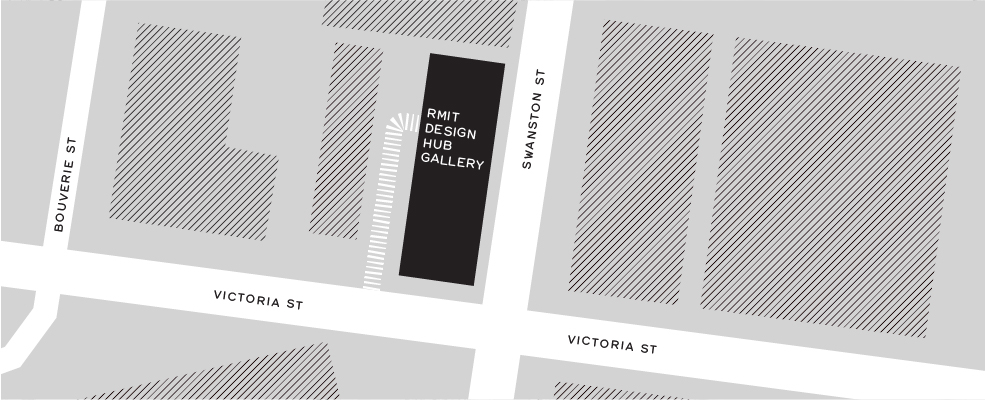Overview
RMIT Design Hub Gallery comprises two large-scale project spaces programmed with exhibitions and engagements that explore contemporary design and its vital role in our world. Produced in collaboration with specialist curators, projects present innovative global research and raise important questions regarding the practice and the future of design.
RMIT Design Hub Gallery acknowledges the people of the Woi wurrung and Boon wurrung language groups of the eastern Kulin Nations on whose unceded lands we work.
To receive updates on our exhibitions and monthly editorial newsletter, subscribe here.
Culture
RMIT Design Hub Gallery is part of RMIT Culture.
RMIT Culture brings together the university’s cultural spaces, creative programs and art, film, design and research collections, providing valuable support for the university’s learning and teaching activities and opportunities to inspire creativity and collaboration. By showcasing and expanding RMIT’s cultural assets through new initiatives, RMIT Culture helps facilitate a University-wide approach to cultural engagement.
Architecture
At the top of the Design Hub forecourt is an installation by landscape architecture and urban design practice Openwork. The project was commissioned by the University with the brief to provide a visual and physical deterrent for vehicles entering the building’s plaza space at speed from adjacent streets. Skeptical of the message that bollards transmit about permission in public space, Openwork proposed a land-form instead of a bollard that doubles as seating for students and passersby. The form is a 1:1 copy of the deliberately imperfect circle paving motif on the existing plaza.
Read more about the project here.
Opening Hours (when exhibition is currently showing)
-
Tuesday to Friday
11am – 5pm -
Saturday
12pm – 4pm -
Sunday and Monday
Closed -
Closed Public Holidays
Location
Level 2, Building 100, RMIT University
Corner Victoria & Swanston Streets
Carlton, Victoria, Australia 3053
Entry to Design Hub Gallery
via the Victoria Street forecourt
Gallery located below street level

Accessibility
Accessibility
Design Hub Gallery welcomes all visitors and is committed to making our exhibitions and programs accessible to everyone.
For Accessibility Resources for Deep Time Real Time please see here
Wheelchair Access
Design Hub Gallery is wheelchair accessible and there is a disabled parking space just outside on Swanston Street. The gallery is located on level 2, one floor down from street level. Please note street level in Building 100 is level 3.
You can enter via the lifts on level 3 just inside the buildings main entrance at the corner of Victoria and Swanston Streets or via the Victoria Street ramp.
Wheelchair accessible bathrooms are located on street level and within the gallery itself. The gallery is an open plan space, with no stairs or elevated areas.
Guide Dogs
Guide dogs are welcome at Design Hub Gallery.
Hearing Loops
Hearing loops are available in both gallery spaces.
Blind Or Low Vision
All wayfinding signage in the gallery spaces include Braille and raised letters.
Contact Us
Contact Us
RMIT Culture
RMIT Design Hub Gallery is part of RMIT Culture.
RMIT Culture brings together the university’s cultural spaces, creative programs and art, film, design and research collections, providing valuable support for the university’s learning and teaching activities and opportunities to inspire creativity and collaboration. By showcasing and expanding RMIT’s cultural assets through new initiatives RMIT Culture helps facilitate an enterprise-wide approach to cultural engagement.
TO KEEP UP TO DATE WITH THE LATEST NEWS ON EXHIBITIONS AND EVENTS AT RMIT GALLERIES – JOIN OUR MAILING LIST HERE!
General information: galleries@RMIT.edu.au
*Please note that Design Hub Gallery is not available for event hire, photoshoots or exhibitions that have not been selected through our annual program call-out. If you are interested to apply, please sign-up to our mailing list for future alerts.
Group Bookings
Please email us at galleries@rmit.edu.au to organise your visit
In your request please include the following information:
- Group leader(s) name, email address and contact number
- Desired date and time for visit (RMIT Gallery is open 11am-4pm Tuesday-Friday and Saturday 12pm-5pm during exhibition dates)
- Name of institution and subject/course of study (if relevant)
- Number of people in your group and educators or supervisors
- If any members of your group have accessibility requirements
We require all groups of ten or more people to book their visit to RMIT Gallery in advance. Bookings are essential to minimise clashes with other events and programming.
Requests for group bookings must be made at least two weeks in advance of your planned visit date.
We strongly encourage educators to visit our exhibitions before booking a group visit. If you have any questions about the exhibition and/or specific artworks, please mention this during your booking so we can best support your visit.
Introductory talks given by Gallery staff are available upon request and are subject to staff availability. Introductory talks provide a brief overview of the exhibition and run for approximately five to ten minutes. Teachers and educators are then responsible for group engagement with the exhibition. If you are interested in an introductory talk for your group, please mention this whilst booking. Introductory talks will not be available for groups booking within two weeks of their visit or who arrive at the gallery without making a booking in advance.
For primary and secondary school groups, adult supervision of students is required at all times, at no time will RMIT Gallery assume responsibility for your group. Please find below the required teacher-to-student ratios and ensure the adequate number of teachers and/or guardians are present during your visit:
- 1:5 for primary groups
- 1:10 for secondary groups
- 1:20 for tertiary groups

